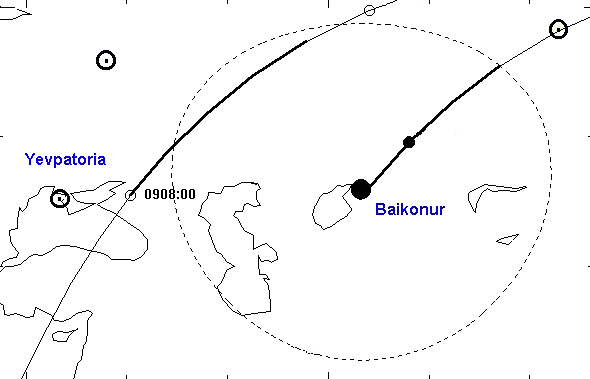
The main conclusion of the article is "….It became clear that Cosmos 57 had been an automatic prototype to test the operation of the airlock. Finding out what went wrong with the test and why its failure did not delay Voskhod 2 has been an interesting exercise…".
The article identified the following events that could be monitored through telemetry:
Cosmo 57 was launched at 0730 UT on 22 February 1965. U.S. sensors picked up the telemetry 17 minutes later and the airlock was the already deployed and a test of opening and closing the outer hatch is in progress. At 0748:36 UT the hatch is closed. The next step is to pressurise the chamber by opening a valve from the main cabin. This command is given at 0750:47 and telemetry shows that it was accepted. Despite indications through telemetry that the pressure in the airlock and cabin are the same, 0.7 atmospheres, the ground station keeps repeating the valve open command every four seconds. However another command transmitter starts sending the same command, but the onboard decoder mistook these two identical command as the "mirror image" command, i.e. valve close (this is explained in some detail in the article).
However, and this seems a bit cryptic in the article:"….it recognised the synthetic code as the one-or close enough to it-which was to command that retrofire begin…." This was seen in the telemetry channels that indicated the status of the descent system. But the ground controllers at the sites in Kamchatka may not have understood what had happened and the spacecraft passed out of range without any counter-command having been sent.
When U.S. sensors pick up the spacecraft again, the airlock was still attached and pressurised, but the "pressure in the retro bottle" was almost gone. The spacecraft was also tumbling at 78 rpm, so retrofire had occurred, but had not resulted in a descent trajectory.. But the ground controllers still transmitted the valve close command. This occurred at 0904:40 UT, but shortly afterwards the destruct system was activated. The spacecraft passed the eastern Mediterranean and Turkey, so there were probably more than one U.S. tracking facility that followed the flight at that time. It is known that there probably was an NSA listening post at Karamursel near Istanbul (4) (5) .
According to excerpts from Kamanin's diary (3), the deployment of the inflatable airlock had been observed on the direct TV link from the spacecraft at the tracking station in the Crimea (Yevpatoria) and also briefly at Baikonur, despite the low elevation angle. This what Kamanin writes: "During the first orbit, the craft was observed by special television circuit at Simferopol and Moscow. We [presumably at Baikonur. SG:s comment] also gathered around the television set, though not really expecting to catch a glimpse of the craft, since during the first orbit it was quite far from the proving grounds. Quite unexpectedly, a distinct image of the front part of the airlock appeared on the screen, causing an outburst of joy among all present...".

If one compares this with the U.S. story above, the craft was the in deep trouble and tumbling. It seems that analysis of what went on in orbit made by the Soviet control center was not all that rapid, because Kamanin wites he was one of the heads of operations center shifts and he was not due to go on duty until 1300 UT, so he went off to have a meal and "relax a little", thinking that all was well. Say that he left the control center just after 0915UT and came back, as he says, two hours later. He would have been back in the control center at around 1115 UT and Korolev then told him that the "the craft has blown up".
Kamanin goes on to explain that the failure investigation revealed that "General Karas took no special measures to prevent the measurement points from working in concert, merely issuing the customary instruction that IP-6 was the main station, and IP-7 the backup, i.e. it could send commands to the craft only upon further orders from Moscow. The commander of IP-7 violated this instruction and sent a command at a time when he was supposed to 'keep quiet'...".
![]()